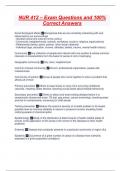NUR 412 – Exam Questions and 100%
Correct Answers
Social Ecological Model ✅Recognizes that we are constantly interacting with and
influenced by our surroundings
- Societal (social and cultural norms, policy)
- Community (neighborhoods, schools, workplace, social or religious organizations)
- Relationship (family, peers, partner, other social networks)
- Individual (age, education, income, attitudes, beliefs, trauma, mental health history)
Community ✅Any collection of people who interact with one another & whose common
interests or characteristics form the basis for sense of unit or belonging
Geographic community ✅City, town, neighborhood
Common interest community ✅Church, professional organization, people with
mastectomies
Community of solution ✅Group of people who come together to solve a problem that
affects all of them
Primary prevention ✅Efforts to keep illness or injury from occurring (childhood
vaccines, installing safety devices, teaching young adults about lifestyle behaviors)
Secondary prevention ✅Efforts to detect and treat existing disease before it is
symptomatic (breast self exam, TB test, pap smear, cancer screenings, checking water
and soil for contaminants, screening for child abuse)
Tertiary prevention ✅Reduce the extent & severity of a health problem to its lowest
possible level to minimize disability & restore or preserve function (recalling foods,
notifying people of chemical spills)
Epidemiology ✅Study of the distribution & determinants of health-related states of
events, & the application of this study to the control of the diseases & other health
problems
Endemic ✅Disease that constantly presents in a particular community or region (flu)
Epidemic ✅Occurrence of a great number of cases of a disease than ordinarily
expected in a given population (smallpox)
, Outbreak ✅Increased number of cases in the population that does not approach
epidemic proportions (ebola)
Pandemic ✅Simultaneous experience of extensive disease outbreaks or epidemics in
several parts of the world (COVID)
Mortality rate ✅Ratio of the number of deaths in various categories (in a specified time
period) to the number of people in a given population (at the time period)
Incidence ✅Number of new cases of a particular population identified during a
specified time period
Incidence rate ✅(number of new cases of a condition last year / total population at risk
at midyear) x 1000
Prevalence ✅Total # of people affected by a particular condition at a specified time
period (new + old cases) divided by the total population at risk during that time period
Prevalence rate ✅(total number of cases of a condition last year / total population at
risk at midyear) x 1,000
Epidemiology triad model ✅Host, agent, environment
Host (epidemiology triad model) ✅Susceptible human or animal who harbors &
nourishes an agent (age, sex, race, genetic profile, previous diseases, immune status,
religion, customs, occupation, marital status, family background)
Agent (epidemiology triad model) ✅Factor that causes or contributes to a health
problem or condition (biologic [bacteria, viruses], chemical [poison, alcohol, smoke],
physical [trauma, radiation, fire], nutritional [lack, excess])
Environment (epidemiology triad model) ✅All external factors that might influence a
host's resistance or vulnerability (temperature, humidity, altitude, crowding, housing,
neighborhood, water, milk, food, radiation, pollution, noise)
Strongest evidence ✅Randomized Control Trial (RCT)
Weakest evidence ✅Case reports/case studies
Absolute risk (AR) ✅Probability that anyone in a given population will develop a
particular condition
Relative risk (RR) ✅Probability that someone in a group of people will develop the
condition when compared to people without the characteristic




